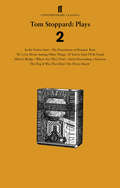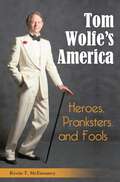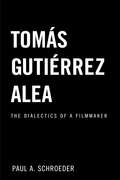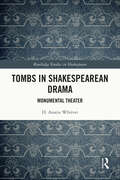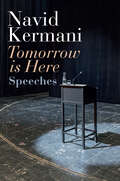- Table View
- List View
Tom Stoppard: The Moral Vision of the Major Plays
by P. DelanyEvery four or five years Britain's most prominent dramatist pulls out all the stops and writes a major stage play of his own. Between plays, Stoppard the craftsman does translations, screenplays, light entertainments, and work for hire. Delaney's book is the first to focus on the major plays. Spanning Stoppard's career from Rosencrantz and Guildenstern are Dead (1967) to Hapgood (1988), this study shows the figure which Stoppard from the first has been weaving in his theatrical tapestry. That there is development in Stoppard is clear but - as Delaney demonstrates - the development is from moral affirmation to moral application, from the assertion of moral principles to the enactment of moral practice. Such development from precept to praxis demonstrates organic growth rather than radical metamorphosis. Using Stoppard's words in a number of little-known interviews as a starting-point, Delaney shows how the major plays bear out Stoppard's contention that he 'tries to be consistent about morality'. The volume contains the most extensive bibliography and discography of Stoppard interviews (over 200 including print and broadcast sources) ever compiled.
Tom Stoppard Plays 2: The Dissolution of Dominic Boot; 'M' is for Moon Among Other Things; If You're Glad I'll Be Frank; Albert's Bridge; Where Are They Now?; Artist Descending a Staircase; The Dog It Was That Died; In the Native State; On 'Dover Beach'
by Tom StoppardThis second collection of work by Tom Stoppard contains his radio plays, which complement (and sometimes prefigure) his work for the stage. The volume includes In the Native State, which became the stage play Indian Ink.Also in this volume are The Dissolution of Dominic Boot, 'M' is for Moon Among Other Things, If You're Glad I'll Be Frank, Albert's Bridge, Where Are They Now?, Artist Descending a Staircase, The Dog It Was That Died and an introduction by the author. This new edition contains the previously unpublished radio play, On 'Dover Beach'.
Tom Stoppard's Arcadia (Modern Theatre Guides)
by John FlemingTom Stoppard is widely regarded as one of the leading contemporary British playwrights, a writer who has earned an intriguing mix of both critical and commercial success. Arcadia is considered by many critics to be Stoppard's masterpiece, a work that weds his love for words and ideas in his early career, with his emphasis on storytelling and emotional engagement in his later career. With its engaging alteration between past and present Arcadia offers a comedic and entertaining exploration of chaos theory, entropy, the Second Law of thermodynamics, iterated algorithms, fractals, and other concepts culled from the realms of math and science.
Tom Stoppard's Arcadia (Modern Theatre Guides)
by John FlemingTom Stoppard is widely regarded as one of the leading contemporary British playwrights, a writer who has earned an intriguing mix of both critical and commercial success. Arcadia is considered by many critics to be Stoppard's masterpiece, a work that weds his love for words and ideas in his early career, with his emphasis on storytelling and emotional engagement in his later career. With its engaging alteration between past and present Arcadia offers a comedic and entertaining exploration of chaos theory, entropy, the Second Law of thermodynamics, iterated algorithms, fractals, and other concepts culled from the realms of math and science.
Tom Wolfe's America: Heroes, Pranksters, and Fools
by Kevin T. McEneaneyWhile The Right Stuff and The Bonfire of the Vanities remain perhaps his best-known works, Tom Wolfe's journalism and fiction continues to enjoy a large audience, perhaps chiefly because of the variety of his subjects and his controversial approach to them. Here, McEneaney offers an account of the man and his works, explaining along the way Wolfe's use of irony, his obsessive themes, and even his use of pranks. More comprehensive in scope than any preceding book on Wolfe, it offers accurate and accessible commentary based upon what Wolfe admits about his own work.In this new book, Wolfe's work is put in journalistic and literary context. The reliability of Wolfe's journalism is discussed, especially when there are alternative narrations to events he has depicted. McEneaney also examines the Wolfe's use of pranks that he plays on readers at times, and uncovers the influences on Wolfe that have contributed to his unique style. Finally, the author discusses Wolfe's impact on other writers. Readers will gain access into Wolfe's world through this detailed and colorful work.
Tomas Gutierrez Alea: The Dialectics of a Filmmaker
by Paul A. SchroederFirst Published in 2003. Routledge is an imprint of Taylor & Francis, an informa company.
Tomas Gutierrez Alea: The Dialectics of a Filmmaker
by Paul A. SchroederFirst Published in 2003. Routledge is an imprint of Taylor & Francis, an informa company.
Tombs in Shakespearean Drama: Monumental Theater (Routledge Studies in Shakespeare)
by H. Austin WhitverTombs in Shakespearean Drama explores the rhetorical deployment of tombs and monuments on the early modern stage, demonstrating their historiographic power and mythmaking potential. By analyzing references to tombs in plays by Shakespeare and others in conjunction with extant monuments, this volume demonstrates how these references function in two overlapping ways in period drama: monuments act as repositories of information about the past, and they allow the living to construct and preserve fictive narratives. The stage exposes the flimsy materiality of paper, placing less value on the written word than period poetry. In this way, critics have perhaps oversold as universal Shakespeare’s poetic praise of stone. Tombs within plays act as a powerful historical and narrative medium, raising the stakes to provide the stage with the illusion of permanency. Playwrights use tombs to anchor the stage action, giving a sense of lasting importance to dramatic events and combatting the ephemeral nature of the playhouse. In drama, Shakespeare and others drew on the persona preserved on tombs; this volume widens our view of how these representations interacted in the commemorative economy of early modern England. Within the playhouse, it was the tomb, not the tome, that stood as a symbol of permanence.
Tombs in Shakespearean Drama: Monumental Theater (Routledge Studies in Shakespeare)
by H. Austin WhitverTombs in Shakespearean Drama explores the rhetorical deployment of tombs and monuments on the early modern stage, demonstrating their historiographic power and mythmaking potential. By analyzing references to tombs in plays by Shakespeare and others in conjunction with extant monuments, this volume demonstrates how these references function in two overlapping ways in period drama: monuments act as repositories of information about the past, and they allow the living to construct and preserve fictive narratives. The stage exposes the flimsy materiality of paper, placing less value on the written word than period poetry. In this way, critics have perhaps oversold as universal Shakespeare’s poetic praise of stone. Tombs within plays act as a powerful historical and narrative medium, raising the stakes to provide the stage with the illusion of permanency. Playwrights use tombs to anchor the stage action, giving a sense of lasting importance to dramatic events and combatting the ephemeral nature of the playhouse. In drama, Shakespeare and others drew on the persona preserved on tombs; this volume widens our view of how these representations interacted in the commemorative economy of early modern England. Within the playhouse, it was the tomb, not the tome, that stood as a symbol of permanence.
Tomorrow is Here: Speeches
by Navid KermaniNavid Kermani is not only one of Germany&’s most distinguished writers and public intellectuals, he is also an outstanding public speaker who mesmerizes audiences with his well-crafted sentences and turns of phrase. Whether he is speaking about the plight of refugees or delivering a eulogy at his father&’s graveside, Kermani finds words that surprise his listeners, enlighten them, provoke them, disturb them or move them to tears. As a German of Iranian descent whose parents settled in Germany, Kermani is particularly sensitive to the issues raised by migration and the perceived tensions between Islam and the West. His speeches are a powerful demonstration of how much we stand to gain by adhering to the values of openness, tolerance and mutual respect for the beliefs and practices of those from other cultures who live among us.
Tone: A Linguistic Survey
by Victoria A. FromkinTone: A Linguistic Survey is a nine-chapter text that considers the phonetics and phonology of tone from both a synchronic and a diachronic point of view. The first chapters deal with the physiological and perceptual correlations of tone. These chapters also describe the interactions of tonal and nontonal features. The succeeding chapters provide the phonetic basis for phonological tonal phenomena. These topics are followed by discussions of the physical and physiological aspects of tone, the number of possible contrastive tones in a language, and a suprasegmental representation of tones based on linguistic evidence. This text also summarizes the kinds of tone rules found in languages and the important syntactic function played by tone in a number of the world's languages, particularly those in Africa. The final chapters look into the general and specific principles that constrain historical tone change. This book will prove useful to students with phonology course.
Tone: Writing and the Sound of Feeling
by Judith RoofTone is often decisive in whether we love or dislike a story, novel, or even critical essay. Yet literary critics rarely treat tone as a necessary or important element of literary style or critique. There are surprisingly few analyses of what tone is, how texts produce tone, or the ways tone--as an essential element of narration--contributes to character, story, mood, and voice. Tone's 24 micro-chapters offer a playful, eclectic, and fast-paced guide into the creation of tone in a variety of modern and contemporary works of literature by such varied writers as Hemingway, Woolf, and Sedaris, as well as in criticism, advertising, and machine-authored texts. Judith Roof shows how tone is a crucial element in all writing, as it produces the illusion of a telling voice; creates a sense of character, personality, and attitude; inflects events recounted; anticipates certain directions and possibilities; and creates an ambiance that simultaneously produces, enables, and shapes narratives and characters. Tone gives us a lively and original way to rethink the practice of literary criticism.
Tone: Writing and the Sound of Feeling
by Judith RoofTone is often decisive in whether we love or dislike a story, novel, or even critical essay. Yet literary critics rarely treat tone as a necessary or important element of literary style or critique. There are surprisingly few analyses of what tone is, how texts produce tone, or the ways tone--as an essential element of narration--contributes to character, story, mood, and voice. Tone's 24 micro-chapters offer a playful, eclectic, and fast-paced guide into the creation of tone in a variety of modern and contemporary works of literature by such varied writers as Hemingway, Woolf, and Sedaris, as well as in criticism, advertising, and machine-authored texts. Judith Roof shows how tone is a crucial element in all writing, as it produces the illusion of a telling voice; creates a sense of character, personality, and attitude; inflects events recounted; anticipates certain directions and possibilities; and creates an ambiance that simultaneously produces, enables, and shapes narratives and characters. Tone gives us a lively and original way to rethink the practice of literary criticism.
Tone and Accent in Oklahoma Cherokee (Oxford Studies of Endangered Languages #3)
by Hiroto UchiharaThis book examines the tone and accent of Oklahoma Cherokee, in which six possible pitch patterns can occur on a syllable: low, high, low-high, high-low, lowfall, and superhigh. It provides a comprehensive description and analysis of these patterns, examining their distribution, their source, the principles that determine their positions, and the nature of tonal alternations. The tone and accent of Oklahoma Cherokee displays some typologically unusual features, such as the glottal stop as the historical source for both high and lowfall tones, the coexistence of tonal and accentual systems, the existence of multiple accentual systems, and the morphosyntactic use of accents. Studies on tones in general have focused mainly on analytical languages or languages with little morphology, but Cherokee is unique in that it is polysynthetic at the same time as tonal. The emergence of tones in Oklahoma Cherokee is recent and its source is easily traceable, but the language has already developed a complex tonal alignment and tonal phonology. Hiroto Uchihara's description of tone and accent in Oklahoma Cherokee will not only contribute to a deeper understanding of the sound system of Cherokee, but will also advance the historical study of Iroquoian languages as a whole, and the typological study of tonal and accentual systems more generally.
Tone Evolution: The Uni- and Multi-Phonational Tone Systems on the Jianghan Plain (Prosody, Phonology and Phonetics)
by Caiyu WangThis book provides a start of defining the uni- and multi-phonational tone systems of geographically-connected dialects under a phonation-pitch tonal model. It also demonstrates an interpretation of the contemporary ongoing tonal variations and varieties from the perspective of language evolution. Acoustic data are collected from five adjacent counties on the Jianghan Plain in China, where two varieties of Southwestern Mandarin and one variety of Gan Dialect are spoken. Falsetto and breathy phonations are applied in this area for phonological distinction, and thus the modal-only dialects co-occur with the di-phonational (falsetto and modal) and tri-phonational (falsetto, modal, and breathy) ones. The acoustic and perceptual analyses are conducted to define tones under the Multi-Register Four-Level Tonal Model, a frame considering both pitch and phonation for the definition of tones. The synchronic variations and varieties within and across speakers/dialects are interpreted in the dynamic interplay of tones mainly governed by phonetic and phonological reasons. The inner-system tonal differences of individual dialectal varieties together with the general distributive patterns of tones in this area are evaluated to determine the paths of tone evolution.Fresh for it exploring the definition and linguistic meaning of the dynamic modal- and non-modal tones, the book benefits researchers with data, research methods, and insight and helps the language teachers and learners understand and learn tones with what the lexical tones really are. The book is also written for the readers curious of tones and tone languages.
Tone in Lexical Phonology (Studies in Natural Language and Linguistic Theory #4)
by Douglas PulleyblankThis book is a revised version of my Ph.D. dissertation that was submitted to the Massachusetts Institute of Technology in 1983. Although much of the analysis and argumentation of the dissertation has survived rewriting, the organization has been considerably changed. To Paul Kiparsky and Morris Halle, lowe a major debt. Not only has it been a great privilege to work on phonology with both of them, but it is hard to imagine what this piece of research would have looked like without them. (They, of course, may well imagine a number of appropriate ways in which the work could be different had I not been involved .... ) In addition, special thanks are due to Ken Hale, the third member of my thesis committee. Our discussions of a variety of topics (including tone) helped me to keep a broader outlook on language than might have otherwise been the result of concentrating on a thesis topic.
Tongue Ties: Logo-Eroticism in Anglo-Hispanic Literature (New Directions in Latino American Cultures)
by G. Firmat'Before it becomes a political, social, or even linguistic issue, bilingualism is a private affair, intimate theater'. So writes Firmat in this ground-breaking study of the interweaving of life and languages in a group of bilingual Spanish, Spanish-American and Latino writers. Unravelling the 'tongue ties' of such diverse figures as the American philosopher George Santayana, the emigré Spanish poet Pedro Salinas, Spanish American novelists Guillermo Cabrera Infante and María Luisa Bombal, and Latino memoirists Richard Rodriguez and Sandra Cisneros, Firmat argues that their careers are shaped by a linguistic family romance that involves negotiating between the competing claims and attractions of Spanish and English.
Tongues of Fire: Language and Evangelization in Colonial Mexico
by Nancy FarrissIn Tongues of Fire, Nancy Farriss investigates the role of language and translation in the creation of Mexican Christianity during the first centuries of colonial rule. Spanish missionaries collaborated with indigenous intellectuals to communicate the gospel in dozens of unfamiliar local languages that had previously lacked grammars, dictionaries, or alphabetic script. The major challenge to translators, more serious than the absence of written aids or the great diversity of languages and their phonetic and syntactical complexity, was the vast cultural difference between the two worlds. The lexical gaps that frustrated the search for equivalence in conveying fundamental Christian doctrines derived from cultural gaps that separated European experiences and concepts from those of the Indians. Farriss shows that the dialogue arising from these efforts produced a new, culturally hybrid form of Christianity that had become firmly established by the end of the 17th century. The study focuses on the Otomangue languages of Oaxaca in southern Mexico, especially Zapotec, and relates their role within the Dominican program of evangelization to the larger context of cultural contact in post-conquest Mesoamerica. Fine-grained analysis of translated texts reveals the rhetorical strategies of missionary discourse. Spotlighting the importance of the native elites in shaping what emerged as a new form of Christianity, Farriss shows how their participation as translators and parish administrators helped to make evangelization an indigenous enterprise, and the new Mexican church an indigenous one.
Tongues of Fire: Language and Evangelization in Colonial Mexico
by Nancy FarrissIn Tongues of Fire, Nancy Farriss investigates the role of language and translation in the creation of Mexican Christianity during the first centuries of colonial rule. Spanish missionaries collaborated with indigenous intellectuals to communicate the gospel in dozens of unfamiliar local languages that had previously lacked grammars, dictionaries, or alphabetic script. The major challenge to translators, more serious than the absence of written aids or the great diversity of languages and their phonetic and syntactical complexity, was the vast cultural difference between the two worlds. The lexical gaps that frustrated the search for equivalence in conveying fundamental Christian doctrines derived from cultural gaps that separated European experiences and concepts from those of the Indians. Farriss shows that the dialogue arising from these efforts produced a new, culturally hybrid form of Christianity that had become firmly established by the end of the 17th century. The study focuses on the Otomangue languages of Oaxaca in southern Mexico, especially Zapotec, and relates their role within the Dominican program of evangelization to the larger context of cultural contact in post-conquest Mesoamerica. Fine-grained analysis of translated texts reveals the rhetorical strategies of missionary discourse. Spotlighting the importance of the native elites in shaping what emerged as a new form of Christianity, Farriss shows how their participation as translators and parish administrators helped to make evangelization an indigenous enterprise, and the new Mexican church an indigenous one.
Toni Morrison: Paradise, Love, A Mercy (Bloomsbury Studies in Contemporary North American Fiction)
by Lucille P. FultzToni Morrison features a collection of ten new essays by noted Morrison scholars, including recipients of the Toni Morrison Society Book Award. Focusing upon Morrison's most recently published novels (Paradise, Love, A Mercy) the contributors to this volume revisit issues that continue to engage Morrison and are part of the currency of contemporary American literary and cultural history. These selections examine Morrison's ongoing "romance" with African Americans as they continue to battle the demons of race, gender, class, and poverty, to name a few. Together, these essays offer comprehensive and nuanced discussions of Morrison's latest novels and provide new directions for Morrison scholarship in the 21st century. This volume provides students of literature, cultural studies, and history with an overview of Morrison's examination of African American progress and leadership at key moments in American history and culture from the Colonial Period to the present. Through their thematic interconnectedness, the essays reveal Morrison at her most brilliant in her ability to reach into the past to comment on contemporary issues.
Toni Morrison: Paradise, Love, A Mercy (Bloomsbury Studies in Contemporary North American Fiction)
by Lucille P. FultzToni Morrison features a collection of ten new essays by noted Morrison scholars, including recipients of the Toni Morrison Society Book Award. Focusing upon Morrison's most recently published novels (Paradise, Love, A Mercy) the contributors to this volume revisit issues that continue to engage Morrison and are part of the currency of contemporary American literary and cultural history. These selections examine Morrison's ongoing "romance" with African Americans as they continue to battle the demons of race, gender, class, and poverty, to name a few. Together, these essays offer comprehensive and nuanced discussions of Morrison's latest novels and provide new directions for Morrison scholarship in the 21st century. This volume provides students of literature, cultural studies, and history with an overview of Morrison's examination of African American progress and leadership at key moments in American history and culture from the Colonial Period to the present. Through their thematic interconnectedness, the essays reveal Morrison at her most brilliant in her ability to reach into the past to comment on contemporary issues.
Toni Morrison (Routledge Guides to Literature)
by Pelagia GoulimariToni Morrison's visionary explorations of freedom and identity, self and community, against the backdrop of African American history have established her as one of the foremost novelists of her time; an artist whose seriousness of purpose and imaginative power have earned her both widespread critical acclaim and great popular success. This guide to Morrison’s work offers: an accessible introduction to Morrison’s life and historical contexts a guide to her key works and the themes and concerns that run through them an overview of critical texts and perspectives on each of Morrison’s works cross-references between sections of the guide, in order to suggest links between texts, contexts and criticism a chronology of Morrison’s life and works. Part of the Routledge Guides to Literature series, this volume is essential reading for all those beginning detailed study of Toni Morrison and seeking a guide to her work and a way into the wealth of contextual and critical material that surrounds it.




